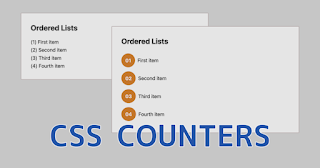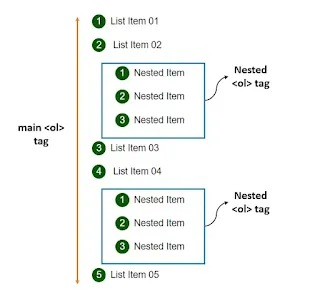Module 39 : CSS Counters & Numbering – Using Counters to Style Ordered Lists Dynamically
focuses on the use of CSS counters, a powerful feature for dynamically numbering elements such as lists, sections, or custom content. Students will learn how to initialize, increment, and display counters using pure CSS—ideal for dynamic document styling without relying on JavaScript.
Learning Objectives
Understand what CSS counters are and how they work.
Create and manipulate counters with CSS.
Style ordered lists and headings dynamically using custom counters.
Apply counters to real-world use cases like table of contents, nested numbering, and styled section headers.
Core Concepts & Explanations
1. What are CSS Counters?
CSS counters are variables maintained by CSS whose values can be incremented by CSS rules and displayed in content using the content property. This allows dynamic numbering of elements such as lists, chapters, sections, or figures.
2. Syntax and How Counters Work
CSS provides three main functions to work with counters:
counter-reset: Initializes or resets the counter to a specific value.
counter-increment: Increases the counter's value.
content: counter(name): Displays the counter value in a pseudo-element (::before or ::after).
3. Step-by-Step Example
Let’s dynamically style an ordered list:
HTML
html code
<ul class="dynamic-list"> <li>First item</li> <li>Second item</li> <li>Third item</li> </ul>
CSS
css
code
.dynamic-list { counter-reset: list-counter; list-style: none; padding: 0; } .dynamic-list li { counter-increment: list-counter; margin: 10px 0; position: relative; } .dynamic-list li::before { content: counter(list-counter) ". "; font-weight: bold; color: #2a9d8f; position: absolute; left: -30px; }
Explanation:
counter-reset initializes the counter named list-counter.
Each <li> increments list-counter by 1.
::before injects the current counter value before each list item with styling.
4. Nested Lists with CSS Counters
CSS counters can be nested, allowing complex structures like multi-level outlines.
HTML
html
code
<ol class="nested-counter"> <li>Section <ol> <li>Subsection</li> <li>Another subsection</li> </ol> </li> <li>Another Section</li> </ol>
CSS
css
code
.nested-counter { counter-reset: section; } .nested-counter > li { counter-increment: section; } .nested-counter > li::before { content: counter(section) ". "; font-weight: bold; } .nested-counter ol { counter-reset: subsection; } .nested-counter ol > li { counter-increment: subsection; } .nested-counter ol > li::before { content: counter(section) "." counter(subsection) " "; margin-left: 20px; font-style: italic; }
5. Styling Headings Like a Table of Contents
HTML
html
code
<div class="toc"> <h2>Introduction</h2> <h2>Chapter One</h2> <h2>Chapter Two</h2> </div>
CSS
css
code
.toc { counter-reset: chapter; } .toc h2 { counter-increment: chapter; } .toc h2::before { content: "Chapter " counter(chapter) ": "; font-weight: bold; color: #264653; }
Exercises
Exercise 1: Custom Ordered List with Icons
Use ::before and counter() to create a custom styled list where each item is prefixed with a number in a circle.
Exercise 2: Multi-Level Numbering
Create a 3-level nested ordered list with full numbering (e.g., 1.2.3).
Exercise 3: Dynamic Section Headings
Style h2 and h3 headers with section numbering like 1., 1.1, 1.2, etc.
Exercise 4: Resume Template
Build a resume layout where experience or project sections are auto-numbered with CSS counters.
Outline
Section
Topic
Time (min)
1
Introduction to CSS Counters
10
2
Basic Counter Implementation
15
3
Styling Ordered Lists
15
4
Nested Numbering with Lists
20
5
Applying to Headings and TOC
15
6
Hands-on Exercises
25
7
Q&A + Wrap-up
10
Assessment and Review
Quiz: Multiple choice and short answers covering counter-reset, counter-increment, and content.
Practical Task: Style a 2-level FAQ section with numbered questions and subquestions.
Conclusion
CSS counters provide a clean, semantic way to handle dynamic numbering and structured content styling without JavaScript. They're ideal for responsive, maintainable designs—especially for documentation, TOCs, and content-heavy layouts.








No comments:
Post a Comment